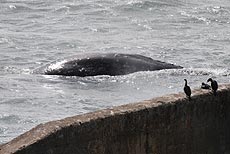 |
Whale Week Begins on Oregon Coast with Gorgeous Weather
Published 12/26/2009
 |
| Whale watching above Manzanita |
(Depoe Bay, Oregon) – That final week of December, from December 26 to January 1, brings the annual winter Whale Watch Week to high vantage points along the coast. With it come dozens of volunteers who help thousands of onlookers to spot gray whales on their winter migration head south for a few months, then returning this way in the spring.
This massive migration goes on much longer than a week, with more than 19,000 whales zipping past this coastline during this big migration. But the Oregon Parks and Recreation Department (OPRD) has designated this week for volunteers to sit at numerous spots to help the public see the cetaceans wandering by.
 |
| A whale plays around close to the Whale Watch Center (photo courtesy Whale Watch Center) |
During this week, from 10 a.m. to 1 p.m., volunteers will be stationed at overlooks and parks all over the Oregon coast, helping the public learn about gray whales as well. Volunteers will be at the Whale Watch Center in Depoe Bay from 10 a.m. to 4 p.m.
While this year the sightings of whales seem to be down slightly – according to the Whale Watch Center’s own site, weather will play a large part in what people see this week. Luckily, weather forecasts seems to bode well for whale sightings.
Clear skies and a calm ocean offer the possibility of exceptional whale watching at this time of year, said Morris Grover, the head of the Whale Watch program.
 |
| Whale near Seaside (photo Seaside Aquarium) |
"Good weather combined with our viewpoints and the expertise of our volunteers can add up to highly rewarding experiences," he said.
Whales are more easily spotted in calmer waters: big waves hide them from view.
Still, even if conditions don’t wind up cooperative the whole time, Grover said chances of seeing the whales during this week are greatly augmented by the volunteers at each of the 26 sites along the coast.
Even more excitement can be had if the weather turns wild and stormy, as those same viewpoints become prime for watching storm waves.
All but two of the overlooks are spaced along the Oregon Coast between Washington's Lewis and Clark Interpretive Center on Cape Disappointment and Crescent City, Calif.
Even in bad weather, Grover said visitors “always have a chance” to spot a whale by following these tips offered by volunteers:
 |
| Whale spouting (photo courtesy Whale Watch Center) |
Have your binoculars ready, but watch with your eyes. "When you locate a blow, then bring up your binoculars for a closer look," said Grover.
Learn the diving and traveling habits of the whales. "Ask a volunteer, or go to our whale watching web site at (www.whalespoken.org) so you will know how often and where they may surface."
If possible, use the morning light, which helps a watcher spot blows. "Afternoon light reflects off the water, shining in your eyes and making viewing difficult. Also, the sea is usually calmer in the mornings because the winds are quieter at those hours." (see video of whale spouting)
While on the coast for either storm watching or whale sighting, Grover advises watchers to bring binoculars and clothing appropriate for these conditions.
 |
| Photo courtesy Whale Watch Center |
"It's best to dress in layers that can be removed as the weather warms up," he said. "The top layer should be waterproof."
Some 18,000 Gray whales are estimated to wander past during this peak migration, and another possible 1,100 humpback whales may be seen as well. Most stay farther out to shore, but some come in quite close, even pausing to check out those whale watch tour boats that really get into high gear during this week.
Storms may affect your ability to see them, but it doesn’t affect the whales. They react more to their food sources, which may have been tossed around and jostled into hiding during heavy surf events.
 |
| Newport's Nye Beach is another hotspot for whale watching. |
“The whales will migrate regardless of weather,” Grover said. “They are driven by nature to get to the Baja for birthing; pregnant females are usually the first whales headed south. Weather is just something they live with. It’s their ocean and they are used to it.”
OPRD coordinates the winter and spring whale watch weeks in partnership with Oregon State University's Hatfield Marine Science Center and Marine Mammal Institute, the University of Oregon's Oregon Institute of Marine Biology, and Washington State Parks, which operates Lewis and Clark Interpretive Center.
More About Oregon Coast lodging.....
 |
 |
 |
RELATED STORIES
Oregon Coast, Valley and Likely Washington Coast to Get Some Aurora Borealis ...
Likely just before dawn best hour but peak happens during daylight. Weather
Dark Sky Week is Prime Along Oregon Coast: Where and Where Not to Go
General guide to dark sky viewing from south to north coast. Astronomy
Sizable Price Drop, Deals in Lincoln City During Quiet of April on Central Or...
20 perc off at A1 Vacation Rentals across its roster, including Gleneden Beach. Lincoln City specials
Upcoming S. Oregon Coast Events Include Gem Show, History: Coos Bay, Bandon
May 6 talk at Coos History Museum, Mayfly Fest May 17, Bandon Rock / Gem Show June 7,8
Washington Coast Cleanup on April 19 - Coinciding with Oregon Coast's SOLVE E...
From the Puget Sound to Long Beach, alongside Oregon's cleanup. Washington coast events, Seaside events
Astoria's Riverwalk Gets New Lighting, More N. Oregon Coast Roadwork
Delays coming this summer, but the riverwalk has a new look. Seaside, Cannn Beach
April Gets Even Cheaper Midweek at Depoe Bay, Lincoln City: Oregon Coast Deals
Off-season rates plus more at Keystone Vacation Rentals. Depoe Bay lodging specials, Lincoln City hotel reviews, Newport hotel reviews
Washington Coast Begins Week of Clam Digs, April 12 Through 18
Long Beach, Twin Harbors, Mocrocks and Copalis at different times. Washington coast events
Astoria's Crab, Seafood, Wine Fest Floods N. Oregon Coast with Yumminess in A...
April 25 to 27 at the Clatsop County Fairgrounds. Astoria events, Cannon Beach events
Oregon Coast Outdoors: Clamming, Crabbing, Surfing, Fishing, Boarding Deep Guide
The wilds of the coast and hang gliding, boating, mussels, hiking, fishing, crabbing, sandboarding, more. Sciences
Earth Week at N. Oregon Coast's Netarts Bay Gets Down, Dirty and Engaging
April 18 - 19 in Netarts: asking for volunteers. Oceanside events, Tillamook events
Plane Skids Off Runway on S. Oregon Coast, Into Coos Bay Waters
All five were rescued and are okay
Secrets of the Season |





































